Seismic Network QC through Teleseism
Modeling
Introduction
The purpose of this package is to compare synthetic
seismograms to observations for teleseismic P, SV and SH in the
distance range of 30 - 95 degrees. Observed waveform are acquired
from data centers, deconvolved, rotated, selected for quality. Using
a given focal mechanism defined by strike, dip, rake, moment
magnitude and source depth, synthetics are compared to the observed
waveforms. A web page is created providing all information on the
processing. Traces are flagged with show a significant departure
between the observed and synthetic waveforms. The flagged
traces may result from incorrect specifications of the instrument
response or from problems with the field instrumentation.
This
QC package was easily created by modifying the existing procedure for
inverting teleseismic waveforms for earthquake source
parameters.
The recent effort to calibrate the Green's
functions against free oscillation code (Synthetics
for a Spherical Earth) suggest the possibility of modifying the
scripts in the current package to also permit a comparison of the
long period mantle surface-waves.
Green's Functions
The suggested location of the Green's functions are in
the directory ${GREENDIR} where the SHELL variable GREENDIR is
defined in the user's ~/.bashrc file. On my system I
define this as
export GREENDIR=/backup/rbh/GREEN
If you use CSHELL then you will do something similar in your .login
or .cshrc file. The reason for specifying the PATH in the
startup file, is that the scripts use the ${GREENDIR}, which means
that the Green's functions can be moved around the file system, only
the definition of GREENDIR changes, and the processing scripts do not
have to be changed.
On my system there are two subdirectories
of teleseismic Green's functions: GREEN.AK135 and AK135.TEL.
The GREEN.AK135 is the older set of Green's functions which may be on
some user systems. The AK135.TEL are those resulting from the
comprehensive test of Earth flattening referenced above. In the
Scripts below OAK135 will refer to the old version and AK135
will refer to the current, preferred version of Green's functions.
There is also a subdirectory Models which has the ASCII files
AK135sph.mod (used for the old Green's functions) and tak135sph.mod
(used for the current, preferred Green's functions).
The Package
The processing package is obtained at mechqctel.tgz.
Download this file and unpack using the command
gunzip -c mechqctel.tgz | tar xvf -
This will create the directory MECHQC.TEL with the following contents
MECHQC.TEL
|-- 0XXXTEL
| |-- 00README
| |-- DAT.TEL
| |-- GRD.TEL
| |-- HTML.TEL
| |-- MT.TEL
| |-- MTD.TEL
| |-- PGRD.TEL
| |-- PMTD.TEL
| |-- SYN.TEL
| `-- USGSMT
| `-- 00README
|-- DO
|-- DOCWBQC
|-- DOWILQC
|-- DOWILQCORFEUS
|-- PROTO.CWB
| |-- CWBDODAT
| |-- CWBDODEC
| |-- CWBDOEVT
| |-- CWBDOGCARC
| |-- CWBDOPREV
| |-- CWBDOQC
| |-- CWBDOQCBBD
| `-- CWBDOROT
`-- PROTO.IU
|-- IDODAT
|-- IDODEC
|-- IDOEVT
|-- IDOGCARC
|-- IDOPREV
|-- IDOQC
`-- IDOROT
Getting Data
There are many ways to get
waveform data for teleseisms. For my purposes, it is sufficient
to obtain the data from the WilberII
interface at IRIS, the Orfeus
data request or from the Internal USGS Continuous Wave Buffer
(CWB). The processing script discussed below is tailed to each
of these sources, e.g., use the DOWILQCORFEUS if you obtain
waveforms data from Orfeus.
After selecting the
earthquake of interest at the IRIS Wilber II or the Orfeus page, you
will see a set of menus that will lead you to the data stream.
In
this tutorial I will display the screens for the event:
IRIS Wilber II
From the IRIS page I will select only the II and IU
networks. There are too many stations for my screendump. At the
bottom of the page I click Proceed to go to the next page.
|
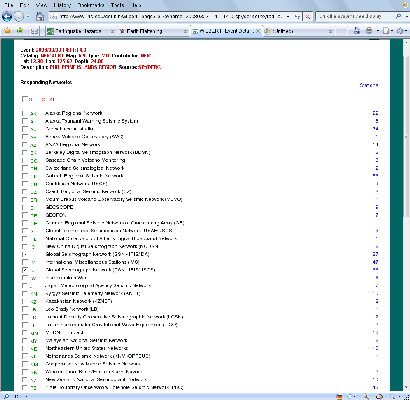
Page 1: Select networks. Here IU and
II (click to enlarge)
|
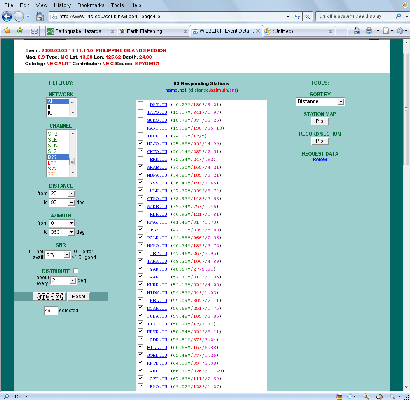
Page 2: Select distance range and
components (and then Apply filter). This is the top of the
page (click to enlarge)
|
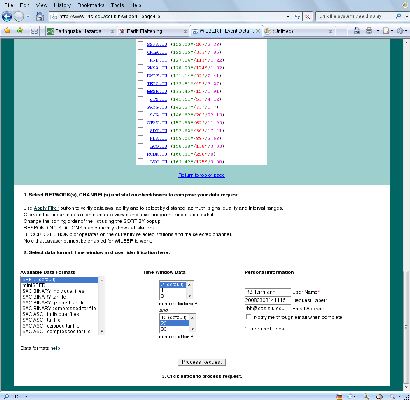
Page 3: (bottom of selection). Select
format, time window, provide UserName and Request Label and the
Proceed (click to enlarge)
|
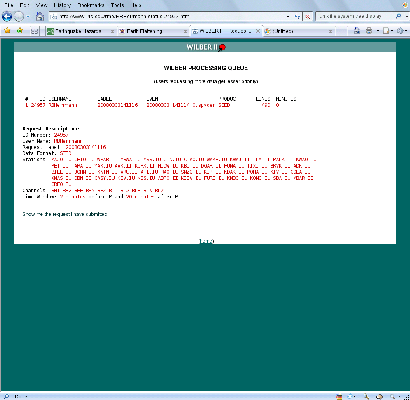
Page 4: Initial display of request
showing processing status. (click to enlarge)
|
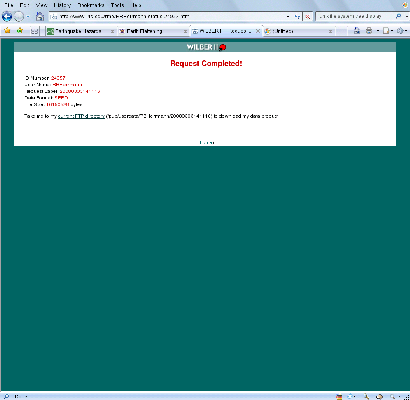
Page 5: Processing complete. the
location of the FTP directory with the SEED volume is provided.
(click to enlarge)
|
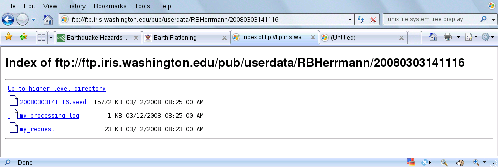
Page 6: Contents of the FTP
directory (click to enlarge)
|
Orfeus Wilber II
I will select only the GEOSCOPE and GEOFON networks for
this example
|
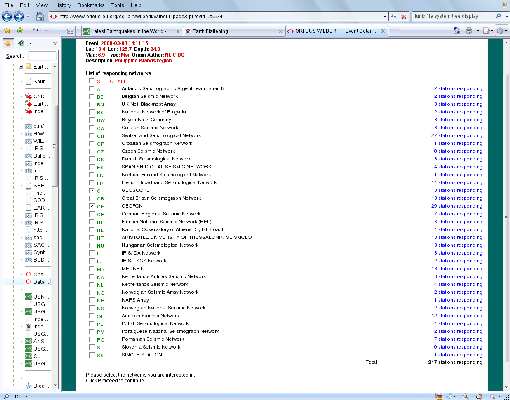
Page 1: Select networks, here the
GEOFON and GEOSCOPE networks are requested (click for a larger
image).
|
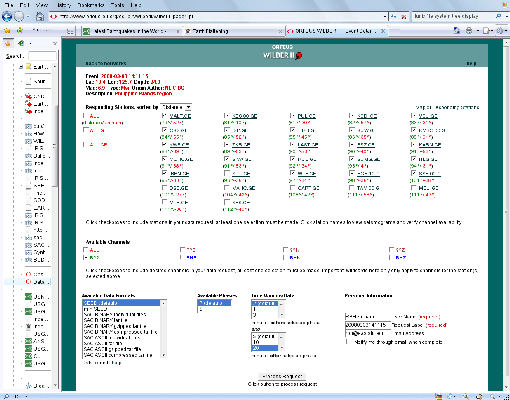
Page 2: Select traces, components
(B??), format, time window, UserName and Request Label (click to
enlarge)
|
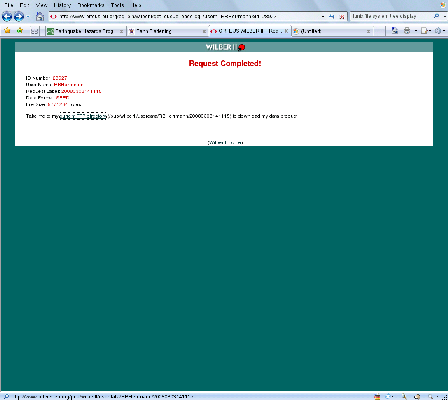
Page 3: After the volume is completed,
the directory on the FTP server with the SEED files is
indicated. (click to enlarge)
|
On this Page 2, I select the
stations in the 30 - 95 degree epicentral distance range, state that
I want everything in SEED, that I want a time window from 2 minutes
before P to 20 minutes after P. Note the User Name and the
Request Label. This must be entered exactly in the DO script
below. The DO script will start the script DOWILQCORFEUS
which will know that the individual trace SEED volumes will be at the
Orfeus ftp site in the specific area
ftp://www.orfeus-eu.org/pub/wilberII/userdata/RBHerrmann/20080303141115
with
names such as
|
GE_CSS__BHE.2008.063.14.11.15.seed
|
64 KB
|
03/12/2008
|
02:58:00 PM
|
|
GE_CSS__BHN.2008.063.14.11.15.seed
|
64 KB
|
03/12/2008
|
02:58:00 PM
|
|
GE_CSS__BHZ.2008.063.14.11.15.seed
|
64 KB
|
03/12/2008
|
02:58:00 PM
|
|
GE_HLG__BHE.2008.063.14.11.15.seed
|
96 KB
|
03/12/2008
|
02:58:00 PM
|
|
GE_HLG__BHN.2008.063.14.11.15.seed
|
96 KB
|
03/12/2008
|
02:58:00 PM
|
Scripts
DO
This script starts everything.
#!/bin/sh
#####
#####
#./DO..QC.. YEAR MO DY HR MN SC MSC LAT(o) LON(o) H(km) MAG MT_DEPTH(km) STRIKE DIP RAKE Mw USERNAME FILE_NAME EVID MODEL
# H(km) is the location depth
# MT_DEPTH(km) is the moment tensor depth
# FILE_NAME is the Identifier given when using the Wilbur II menu - note that the
#####
./DOWILQCORFEUS 2008 03 03 14 11 15 000 13.4 125.7 24.0 6.9 37 133 51 -85 6.8 RBHerrmann 20080303141115 pdbs AK135
./DOWILQC 2008 03 03 14 11 16 000 13.4 125.7 24.0 6.9 37 133 51 -85 6.8 RBHerrmann 20080303141116 pdbs AK135
./DOCWBQC 2008 03 03 14 11 14 000 13.4 125.7 24.0 6.9 37 133 51 -85 6.8 RBHerrmann 20080303141116 pdbs AK135
This script actually defines the parameters for the scripts that do
all the work. The only difference in the scripts is the data
source. Normally only one
data source is examined. I usually
comment out the previous commands by placing an # sign at the
beginning of the line. (Note in this example, I use a slightly
different origin time for the different data streams so that the
contents of each will be placed in different directories for this
tutorial).
There must be exactly 20 entries after the
DO..... These are
YEAR - year of
earthquake
MO - month
DY -
Day
HR -
Hour
MN -
Minute
SC
- Second
MSC - Millisecond of
origin time
LAT - event
latitude in degrees
LON -
event longitude in degrees
H
- source depth from location - ONLY FOR REFERENCE
MAG
- network magnitude - ONLY FOR REFERENCE
MT_DEPTH - depth of
event from the moment tensor --- VERY ESSENTIAL
STRIKE
- NODAL PLANE STRIKE
DIP
- NODAL PLANE DIP
RAKE - NODAL PLANE
RAKE
MW -
MOMENT MAGNITUDE FROM MOMENT TENSOR
USERNAME - UserName use int eh
Wilber II request at IRIS or Orfeus. This is not used in the CWB but
the entry must be here
FILE_NAME -
Name of
the data volume. The IRIS Wilber II creates a directory with this
name and places the SEED volume in the directory with the name
FILE_NAME.seed. The Orfeus WILBUR II, places the individual
trace SEED volumes into a directory with this name. This is not
used in the CWB but the entry is required
EVID - USGS
Event ID -- this is not used, put could be useful to get the
arrival times and other information about the event. If you do now
wish to use this, then enter the uppercase code EVID in this
position.
MODEL - the velocity model to use. The
current choices are AK135 and OAK135, as discussed above.
DOCWBQC
This script acquires waveforms and responses from the
USGS Continuous Wave Buffer (Internal use only) through their query
command. The traces are returned as SAC files, and the
responses in units of counts/nanometer in a sac pole-zero format.
After deconvolution and setting the event parameters with CWBDOROT,
the processing is exactly the same as for the other two scripts.
DOWILQC
This assumes that the waveforms are in the IRIS ftp
area, that all traces are in a single SEED volume. The program
rdseed is used to unpack the volume into SAC files while the
response file is for use with the program evalresp. After
deconvolution and setting the event parameters with IDOROT, the
processing is exactly the same as for the other two scripts.
DOWILQCORFEUS
This assumes that the waveforms are in the IRIS ftp
area, which has one SEED volume for each trace. . The program
rdseed is used to unpack the volumes into SAC files while the
response file is for use with the program evalresp. After
deconvolution and setting the event parameters with IDOROT, the
processing is exactly the same as for the other two scripts.
Processing
The scripts run automatically. They get the waveforms
from the archive, deconvolve traces to ground velocity in meters/sec,
rotate to vertical, radial and transverse components, create
synthetics using the given focal mechanism parameters, and finally
create the web page for review.
If the event is denoted
by 20080303141114 then the documentation is in the
directory
MECHQC.TEL/20080303141114/HTML.TEL - you will see
the organization pattern in the Results links below. The main
page of the documentation is the index.html file, which the
browser will open by default.
Initially there are no plots for
the moment tensor solution as seed in the pages. To get these
you must perform two steps:
put the printer plots of the mechanisms into files
in the directory MT.OTHER. The script DOHTML in HTML.TEL looks
for files with the names usgsmt, usgscmt, cmt, gcmt and bat
to represent moment tensors from the current USGS CMT, the USGS
body-wave moment tensor, the Lamont global CMT (either the cmt or
gcmt ) and the broadband array in Taiwan. By editing the
master script in MECHQC.TEL/0XXXTEL/HTML.TEL/DOHTML one can
permit other sources. For the example here, the files are in
MECHQC.TEL/20080303141114/MT.OTHER
I just go to my email or to a web page, and copy the
text to the file. This is a pure text representation and the
lower-case file name is essential
Go to the HTML.TEL directory and run DOHTML again,
to update the documentation.
Results
The following pages show the results for the various
data sources. Note that the USGS CMT solution did not fit the
teleseismic P-wave signal as well as the USGS Body Wave moment
tensor. I used those parameters for the forward synthetics
DOCWBQC
- USGS Internal Waveform Buffer
DOWILQC
- Data from IRIS DMC
DOWILQCORFEUS
- Data from the Orfeus Data Center
Last Changed March
12, 2008








